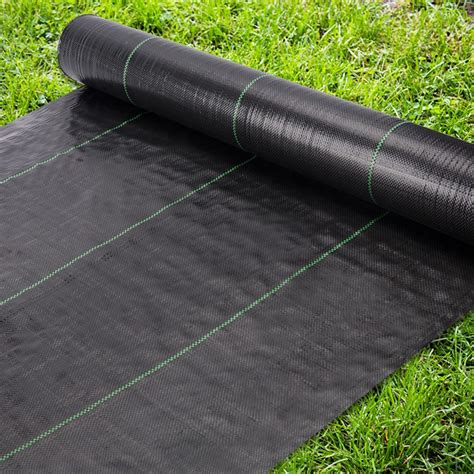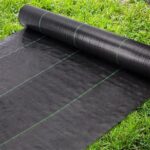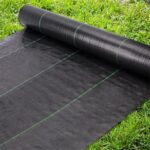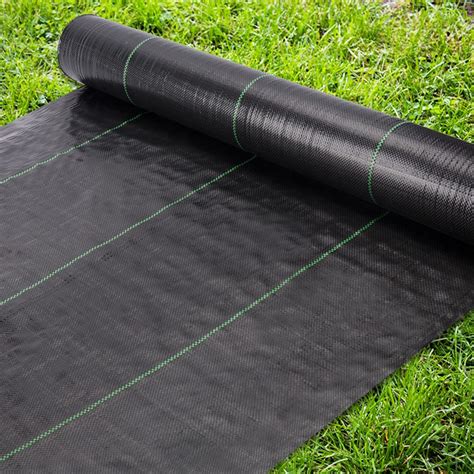
Ditching landscape fabric for eco-friendly alternatives such as mulch, cover crops, and strategic planting offers a more sustainable and effective approach to weed control in gardens and landscapes, promoting healthier soil and plant growth.
Landscape fabric, once a popular choice for weed suppression, is increasingly being recognized as a problematic solution for gardeners and landscapers due to its detrimental effects on soil health and long-term effectiveness. Experts now advocate for a shift towards more ecologically sound methods that not only control weeds but also enhance the overall vitality of the garden. These alternatives, including various mulching techniques, the use of cover crops, and careful plant selection, offer a holistic approach to weed management that benefits both the environment and the plants themselves.
The primary issue with landscape fabric lies in its impact on soil structure and health. While it initially prevents weeds from sprouting by blocking sunlight, it also hinders the natural exchange of air and water between the soil and the atmosphere. This can lead to soil compaction, reduced drainage, and a decrease in beneficial microbial activity. Over time, the fabric itself can degrade, creating a tangled mess that is difficult to remove and further compromises the soil’s integrity. Furthermore, as organic matter decomposes above the fabric, it creates a new layer of soil in which weeds can take root, rendering the fabric ineffective and necessitating additional control measures.
Mulching, on the other hand, offers a multitude of benefits beyond weed suppression. Organic mulches, such as wood chips, shredded bark, and compost, decompose gradually, enriching the soil with nutrients and improving its structure. This creates a healthier environment for plant roots to thrive, making them more resilient to pests and diseases. Mulch also helps to retain soil moisture, reducing the need for frequent watering, and moderates soil temperature, protecting plants from extreme heat and cold. When selecting mulch, it’s essential to consider the specific needs of the plants being grown. For example, acid-loving plants like blueberries and azaleas benefit from acidic mulches like pine needles or oak leaves, while other plants prefer a more neutral mulch like shredded hardwood.
Cover crops are another effective and eco-friendly weed control strategy. These are plants specifically grown to cover the soil and suppress weed growth. They work by outcompeting weeds for resources like sunlight, water, and nutrients. Cover crops also help to improve soil health by adding organic matter, preventing erosion, and fixing nitrogen in the soil. Common cover crops include clover, buckwheat, and rye. The choice of cover crop depends on the season, the specific needs of the soil, and the type of plants being grown. For example, buckwheat is a fast-growing summer cover crop that is effective at suppressing weeds and attracting beneficial insects, while rye is a winter cover crop that helps to prevent soil erosion and improve soil structure.
Strategic planting, also known as companion planting, involves selecting plants that naturally deter weeds or attract beneficial insects that prey on weed seeds. This approach leverages the natural interactions between plants to create a more balanced and resilient ecosystem. For example, planting marigolds near vegetable plants can help to repel nematodes and other pests, while planting herbs like basil and mint can deter common garden pests and attract pollinators. Dense planting can also help to suppress weed growth by shading the soil and preventing weed seeds from germinating. This technique involves planting plants close together to create a living mulch that smothers weeds.
Beyond these primary methods, other eco-friendly weed control strategies include hand-pulling, hoeing, and the use of natural herbicides. Hand-pulling is a simple and effective way to remove weeds, especially when they are young and haven’t yet established deep roots. Hoeing is another manual method that involves cutting weeds off at the soil surface. Natural herbicides, such as vinegar and citrus oil, can be used to spot-treat weeds without harming the surrounding plants or the environment. However, it’s essential to use these herbicides with caution and follow the manufacturer’s instructions carefully.
The shift away from landscape fabric and towards more eco-friendly weed control methods reflects a growing awareness of the importance of sustainable gardening practices. By prioritizing soil health and biodiversity, gardeners can create thriving ecosystems that are more resilient to pests, diseases, and environmental stresses. These methods not only benefit the environment but also lead to healthier and more productive gardens in the long run. As more gardeners embrace these practices, the use of landscape fabric is likely to decline, paving the way for a more sustainable and ecologically sound approach to weed management.
In conclusion, while landscape fabric may seem like a convenient solution for weed control, its negative impacts on soil health and long-term effectiveness make it a less desirable option compared to eco-friendly alternatives like mulching, cover cropping, and strategic planting. By adopting these sustainable practices, gardeners can create healthier, more resilient gardens that benefit both the environment and their own well-being.
Expanding on the Benefits of Mulching
Mulching is arguably one of the most versatile and beneficial eco-friendly weed control methods available to gardeners. Its advantages extend far beyond simple weed suppression, contributing significantly to soil health, moisture retention, and temperature regulation. The key to effective mulching lies in understanding the different types of mulch available and selecting the right one for the specific needs of your garden.
-
Types of Mulch: Mulches can be broadly categorized into organic and inorganic. Organic mulches, such as wood chips, shredded bark, straw, compost, and leaf mold, are derived from plant or animal matter and decompose over time, enriching the soil with nutrients. Inorganic mulches, such as gravel, rocks, and rubber mulch, do not decompose and therefore do not contribute to soil fertility. While inorganic mulches can be effective at suppressing weeds and retaining moisture, they lack the soil-improving benefits of organic mulches.
-
Wood Chips and Shredded Bark: These are popular choices for mulching around trees, shrubs, and flower beds. They are relatively inexpensive, readily available, and provide good weed suppression. Wood chips decompose slowly, providing long-lasting benefits to the soil. Shredded bark is similar to wood chips but has a finer texture and decomposes more quickly.
-
Straw: Straw is an excellent mulch for vegetable gardens and fruit trees. It is lightweight, easy to spread, and provides good weed suppression. Straw also helps to retain soil moisture and insulate the soil from extreme temperatures.
-
Compost: Compost is a nutrient-rich mulch that can be used in a variety of garden settings. It improves soil structure, adds organic matter, and provides essential nutrients to plants. Compost can be made at home from kitchen scraps and yard waste or purchased from a local garden center.
-
Leaf Mold: Leaf mold is a type of compost made solely from fallen leaves. It is a valuable soil amendment that improves soil structure, retains moisture, and provides nutrients to plants. Leaf mold is particularly beneficial for acid-loving plants like rhododendrons and azaleas.
-
Application of Mulch: The proper application of mulch is crucial for its effectiveness. Generally, a layer of mulch 2-4 inches thick is recommended. Avoid piling mulch directly against the stems of plants, as this can create a moist environment that encourages rot and disease. It’s also important to replenish mulch as it decomposes or is displaced by wind and rain.
Delving into the World of Cover Crops
Cover crops are a valuable tool for weed control and soil improvement, often overlooked by home gardeners. These plants are strategically grown to protect and enhance the soil, offering a range of benefits that extend beyond simple weed suppression. Understanding the different types of cover crops and their specific properties is essential for maximizing their effectiveness.
-
Types of Cover Crops: Cover crops can be classified based on their growth habit (annual or perennial), their ability to fix nitrogen, and their primary function. Common categories include:
-
Legumes: Legumes, such as clover, alfalfa, and vetch, are nitrogen-fixing cover crops. They have the ability to convert atmospheric nitrogen into a form that plants can use, enriching the soil and reducing the need for synthetic fertilizers. Legumes are particularly beneficial for improving soil fertility and promoting the growth of nitrogen-demanding crops.
-
Grasses: Grasses, such as rye, oats, and barley, are effective at suppressing weeds, preventing soil erosion, and improving soil structure. They have extensive root systems that bind the soil together, preventing erosion and improving drainage. Grasses also add organic matter to the soil as they decompose.
-
Broadleaves: Broadleaf cover crops, such as buckwheat, mustard, and phacelia, are fast-growing and effective at suppressing weeds. They also attract beneficial insects and pollinators. Buckwheat is particularly useful for breaking up compacted soil and improving soil drainage.
-
-
Planting and Management: The timing of planting and the management of cover crops are crucial for their success. Cover crops are typically planted in the fall or spring, depending on the type of crop and the climate. Fall-planted cover crops provide winter soil protection and suppress weeds in the spring. Spring-planted cover crops can be used to improve soil fertility and suppress weeds during the growing season. Before planting a cover crop, it’s essential to prepare the soil by removing any existing weeds and loosening the soil surface. The cover crop should be sown evenly and watered regularly until it is established. Once the cover crop has served its purpose, it can be terminated by mowing, tilling, or applying a herbicide. The residue from the cover crop can then be incorporated into the soil, where it will decompose and release nutrients.
Exploring Strategic Planting for Natural Weed Control
Strategic planting, also known as companion planting, is a technique that involves selecting plants that naturally deter weeds or attract beneficial insects that prey on weed seeds. This approach leverages the natural interactions between plants to create a more balanced and resilient ecosystem. By carefully choosing the right plant combinations, gardeners can reduce the need for herbicides and other synthetic control measures.
-
Companion Planting Examples:
-
Marigolds and Vegetables: Marigolds are known for their ability to repel nematodes and other soil pests. Planting marigolds near vegetable plants, such as tomatoes, peppers, and eggplant, can help to protect them from these pests and promote healthy growth.
-
Basil and Tomatoes: Basil is a fragrant herb that is often planted near tomatoes to improve their flavor and repel pests like tomato hornworms. Basil also attracts beneficial insects that prey on aphids and other garden pests.
-
Mint and Cabbage: Mint is a strong-smelling herb that can deter cabbage moths, which are a common pest of cabbage and other cruciferous vegetables. Planting mint near cabbage can help to protect the plants from these pests and reduce the need for insecticides.
-
Garlic and Roses: Garlic is known for its antifungal and insecticidal properties. Planting garlic near roses can help to prevent fungal diseases like black spot and deter pests like aphids and Japanese beetles.
-
-
Dense Planting: Dense planting is another strategic planting technique that involves planting plants close together to create a living mulch that smothers weeds. This technique is particularly effective for suppressing annual weeds that germinate in the spring. By planting plants close together, gardeners can shade the soil surface and prevent weed seeds from germinating.
Addressing Common Concerns About Landscape Fabric
While landscape fabric has been widely used for weed control, its drawbacks have become increasingly apparent. Understanding these drawbacks is essential for making informed decisions about weed management.
-
Soil Compaction: Landscape fabric can impede the natural exchange of air and water between the soil and the atmosphere, leading to soil compaction. Compacted soil is difficult for plant roots to penetrate, which can stunt their growth and make them more susceptible to pests and diseases.
-
Reduced Drainage: Landscape fabric can also reduce drainage by preventing water from infiltrating the soil. This can lead to waterlogging, which can damage plant roots and create conditions that favor root rot.
-
Decline in Beneficial Microbial Activity: Landscape fabric can inhibit the growth of beneficial microorganisms in the soil. These microorganisms play a vital role in breaking down organic matter, releasing nutrients, and suppressing soilborne diseases.
-
Difficult Removal: Over time, landscape fabric can degrade and become entangled in plant roots, making it difficult to remove. This can be a major problem when it’s time to renovate a garden bed or replace plants.
-
Weed Seed Germination on Top of Fabric: As organic matter decomposes on top of landscape fabric, it creates a new layer of soil in which weeds can take root. This can render the fabric ineffective and necessitate additional control measures.
Integrating Eco-Friendly Weed Control Methods for a Holistic Approach
The most effective approach to weed control is to integrate multiple eco-friendly methods into a holistic system. This involves combining mulching, cover cropping, strategic planting, and other techniques to create a resilient and sustainable garden ecosystem.
-
Start with Soil Preparation: Before implementing any weed control strategies, it’s essential to prepare the soil properly. This involves removing any existing weeds, loosening the soil surface, and amending the soil with compost or other organic matter.
-
Choose the Right Mulch: Select a mulch that is appropriate for the specific plants being grown and the climate. Organic mulches, such as wood chips, shredded bark, and compost, are generally preferred for their soil-improving benefits.
-
Plant Cover Crops: Incorporate cover crops into the garden rotation to improve soil fertility, suppress weeds, and prevent soil erosion.
-
Utilize Strategic Planting: Choose plant combinations that naturally deter weeds or attract beneficial insects.
-
Practice Regular Maintenance: Regularly monitor the garden for weeds and remove them promptly. Hand-pulling and hoeing are effective methods for controlling small weeds.
-
Consider Natural Herbicides: Natural herbicides, such as vinegar and citrus oil, can be used to spot-treat weeds without harming the surrounding plants or the environment.
By following these guidelines, gardeners can create a thriving ecosystem that is more resilient to pests, diseases, and environmental stresses. These methods not only benefit the environment but also lead to healthier and more productive gardens in the long run.
The Long-Term Benefits of Eco-Friendly Weed Control
Shifting from landscape fabric to eco-friendly weed control offers numerous long-term advantages for gardeners and the environment.
-
Improved Soil Health: Eco-friendly methods like mulching and cover cropping enrich the soil with organic matter, improving its structure, fertility, and water-holding capacity. Healthy soil is essential for plant growth and resilience.
-
Reduced Reliance on Synthetic Chemicals: By adopting eco-friendly weed control strategies, gardeners can reduce their reliance on herbicides and other synthetic chemicals, which can have harmful effects on the environment and human health.
-
Increased Biodiversity: Eco-friendly methods promote biodiversity by creating habitats for beneficial insects, pollinators, and other wildlife. A diverse garden ecosystem is more resilient to pests and diseases.
-
Sustainable Gardening Practices: Eco-friendly weed control is an integral part of sustainable gardening. By prioritizing soil health and biodiversity, gardeners can create thriving ecosystems that benefit both the environment and their own well-being.
-
Cost-Effectiveness: While some eco-friendly weed control methods may require an initial investment, they can be more cost-effective in the long run. For example, mulching can reduce the need for watering and fertilizing, while cover cropping can improve soil fertility and reduce the need for synthetic fertilizers.
Frequently Asked Questions (FAQ)
-
Why is landscape fabric no longer recommended for weed control? Landscape fabric, while initially effective at preventing weeds, can lead to soil compaction, reduced drainage, and a decline in beneficial microbial activity. It can also degrade over time, becoming difficult to remove and allowing weeds to grow on top of it. According to the original article, “Landscape fabric is a synthetic material designed to block weeds, but it can also hinder soil health.”
-
What are the best eco-friendly alternatives to landscape fabric for weed control? The best alternatives include mulching with organic materials like wood chips, shredded bark, or compost; using cover crops like clover or buckwheat; and practicing strategic planting or companion planting. These methods improve soil health while suppressing weed growth.
-
How does mulching help control weeds? Mulching smothers weeds by blocking sunlight, preventing them from germinating. Organic mulches also decompose over time, enriching the soil with nutrients and improving its structure. “Mulch smothers weeds, conserves moisture, and enriches the soil as it breaks down,” the article states, emphasizing its multi-faceted benefits.
-
What are cover crops, and how do they suppress weeds? Cover crops are plants grown specifically to cover the soil and suppress weed growth. They outcompete weeds for resources and improve soil health by adding organic matter and preventing erosion.
-
Is hand-pulling weeds still a viable option for weed control? Yes, hand-pulling is a simple and effective way to remove weeds, especially when they are young and haven’t yet established deep roots. It’s a sustainable method that avoids the use of chemicals and can be particularly useful in small gardens or for spot-treating weeds.
Deep Dive into Different Mulch Types and Their Applications
The selection of mulch is not a one-size-fits-all endeavor. Each type of mulch offers unique benefits and is suited for different applications within the garden. A thorough understanding of these nuances is crucial for maximizing the effectiveness of your weed control strategy and promoting overall plant health.
-
Wood Chips: Wood chips are a readily available and cost-effective option, particularly well-suited for mulching around trees and shrubs. Their slow decomposition rate provides long-lasting weed suppression and contributes to soil moisture retention. However, it’s important to source wood chips from reputable suppliers to avoid potential contaminants or the introduction of unwanted pests.
-
Shredded Bark: Similar to wood chips but with a finer texture, shredded bark offers a more aesthetically pleasing option for flower beds and ornamental gardens. Its quicker decomposition rate compared to wood chips means it requires more frequent replenishment but also contributes more readily to soil enrichment.
-
Straw: Straw is a lightweight and easily spreadable mulch, making it ideal for vegetable gardens. Its loose structure allows for good air circulation and drainage, preventing soil compaction and promoting healthy root growth. However, it’s crucial to distinguish between straw and hay; hay contains seeds that can contribute to weed problems.
-
Compost: Compost is not just a mulch but also a valuable soil amendment. Its nutrient-rich composition provides a boost to plant growth while suppressing weeds and improving soil structure. Compost can be used as a standalone mulch or incorporated into the soil before planting.
-
Leaf Mold: Leaf mold, created from decomposed leaves, is a sustainable and readily available resource for many gardeners. Its high water retention capacity and contribution to soil aeration make it particularly beneficial for moisture-loving plants.
-
Pine Needles: Pine needles are an excellent choice for acid-loving plants like blueberries, azaleas, and rhododendrons. Their slow decomposition rate and acidic nature help maintain the optimal soil pH for these plants.
-
Gravel and Stone Mulch: While not organic, gravel and stone mulches offer excellent weed suppression and drainage, making them suitable for xeriscaping and rock gardens. However, they do not contribute to soil fertility and can increase soil temperature, which may be detrimental to some plants.
The Science Behind Cover Cropping: A Deeper Examination
Cover cropping is more than just a superficial weed control method; it’s a sophisticated strategy that leverages the biological processes of plants to improve soil health and suppress weed growth. A deeper understanding of these processes allows gardeners to optimize their cover cropping practices for maximum benefit.
-
Nitrogen Fixation: Leguminous cover crops, such as clover, vetch, and alfalfa, have a symbiotic relationship with nitrogen-fixing bacteria in the soil. These bacteria convert atmospheric nitrogen into ammonia, a form of nitrogen that plants can use. This process enriches the soil with nitrogen, reducing the need for synthetic fertilizers and promoting the growth of subsequent crops.
-
Soil Structure Improvement: The extensive root systems of cover crops help to bind soil particles together, improving soil structure and reducing erosion. They also create channels in the soil that improve drainage and aeration.
-
Organic Matter Addition: As cover crops decompose, they add organic matter to the soil, which improves its water-holding capacity, nutrient retention, and microbial activity. Organic matter also acts as a food source for beneficial soil organisms.
-
Weed Suppression Mechanisms: Cover crops suppress weeds through a variety of mechanisms, including competition for resources, allelopathy (the release of chemicals that inhibit weed growth), and shading of the soil surface.
-
Breaking Disease Cycles: Certain cover crops can help to break disease cycles by suppressing soilborne pathogens or attracting beneficial organisms that prey on these pathogens.
Strategic Planting and the Art of Plant Guilds
Strategic planting extends beyond simple companion planting and encompasses the concept of plant guilds, which are carefully designed communities of plants that work together to support each other and create a more resilient ecosystem.
-
Plant Guild Principles: Plant guilds are based on the principles of permaculture, which emphasizes the creation of sustainable and self-regulating systems. A typical plant guild includes a central “keystone” species (often a fruit tree or shrub), surrounded by plants that provide various benefits, such as nitrogen fixation, pollination, pest control, and weed suppression.
-
Layering: Plant guilds often incorporate multiple layers of vegetation, from groundcovers to shrubs to trees, to maximize the use of space and resources.
-
Beneficial Insect Attraction: Many plants in a plant guild are chosen for their ability to attract beneficial insects, such as pollinators and predators of pests.
-
Nutrient Cycling: Plant guilds can also be designed to facilitate nutrient cycling, with certain plants drawing nutrients from deep in the soil and making them available to other plants through leaf litter or root exudates.
By understanding the principles of plant guilds, gardeners can create more diverse and resilient ecosystems that require less maintenance and are more resistant to pests and diseases.
Beyond the Basics: Additional Eco-Friendly Weed Control Techniques
Beyond mulching, cover cropping, and strategic planting, several other eco-friendly weed control techniques can be incorporated into a comprehensive weed management strategy.
-
Solarization: Soil solarization involves covering the soil with clear plastic during the hottest months of the year to raise the soil temperature and kill weed seeds, pathogens, and nematodes.
-
Flame Weeding: Flame weeding uses a propane torch to briefly heat weeds, causing them to wilt and die. This technique is most effective on young weeds and can be used in gardens, pathways, and driveways.
-
Vinegar-Based Herbicides: Vinegar-based herbicides contain acetic acid, which can effectively kill weeds by desiccating their foliage. However, vinegar herbicides are non-selective and can also harm desirable plants, so they should be used with caution.
-
Corn Gluten Meal: Corn gluten meal is a natural pre-emergent herbicide that prevents weed seeds from germinating. It is most effective when applied in the spring before weeds begin to sprout.
By incorporating these additional techniques into their weed management strategy, gardeners can further reduce their reliance on synthetic chemicals and create a more sustainable and ecologically sound garden.
This expanded article provides a more comprehensive and in-depth look at eco-friendly weed control methods, going beyond the basics to explore the nuances of mulching, cover cropping, strategic planting, and other techniques. It also addresses common concerns about landscape fabric and highlights the long-term benefits of adopting sustainable gardening practices.









